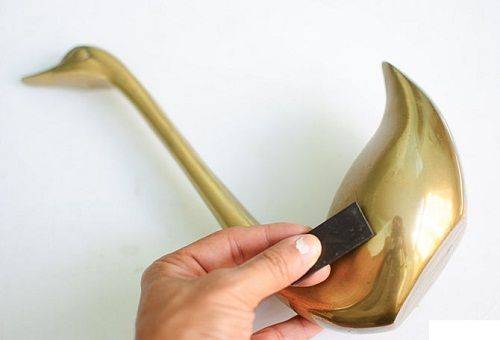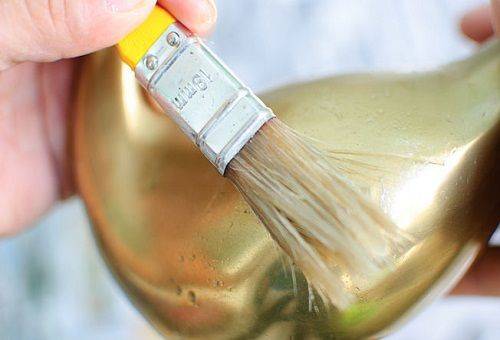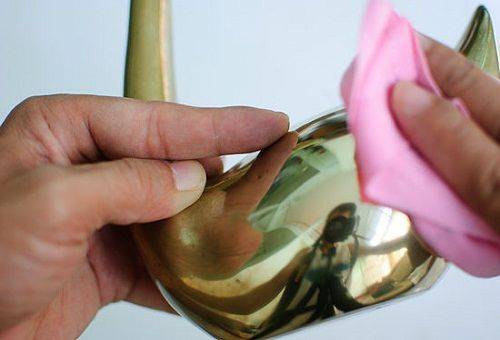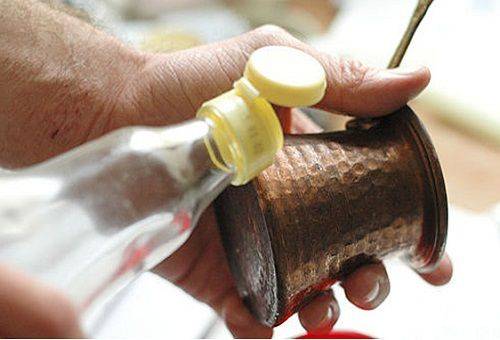What and how can you clean brass at home?
Products made from metal obtained by mixing copper and zinc are distinguished by their original color, resistance to wear and tear and attractive shine. Unfortunately, only a few housewives know how to clean brass and how to do it correctly at home.
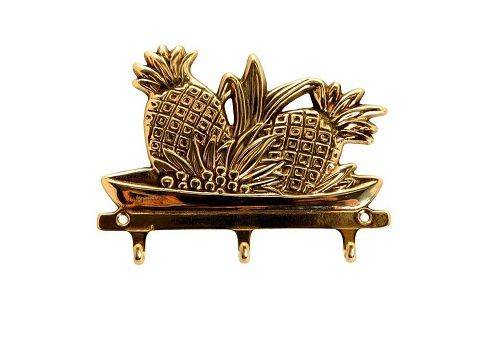
The majority of people most often simply store original figurines, jewelry and tableware in closets. In fact, there are a lot of methods for restoring the original appearance of brass. All of them are accessible and safe. It is not at all necessary to seek help from professionals or purchase aggressive chemicals.
Before cleaning brass with one of the folk remedies or household reagents, you need to make sure that the product is actually made of this alloy. To do this, take a very small magnet and apply it to the object. If it is attracted, then in this case we are not talking about brass.
The most effective methods for cleaning brass products
First of all, to update the appearance of brass products, experts recommend using the following products:
- Gels with the addition of oxalic acid. Ideal for clearing obvious but not long-term stains. Oxalic acid is found in most cleaning products. Simply apply the selected product to the product and leave for a few minutes. As soon as the working surface becomes even darker, you need to start treating it with a brush.Then fill the item with baking soda and rinse all components under running water.
- Oxalic acid in its pure form. If the previous approach does not give the desired results, you will have to clean the product with a base product. We take no more than 20 g of composition per liter of liquid. Soak the item in the resulting solution for a short time and clean it with a brush. Work must be carried out wearing a respirator and gloves.
Advice: It is best to avoid using formulations based on acetic, citric and hydrochloric acid. They give quick results, but in inexperienced hands they can cause damage to the product.
- Acetone. First, simply wipe the brass with a swab soaked in acetone. If positive changes are not obvious, then before such treatment we soak the product in a solution of water, salt and vinegar, brought to a boil. For maximum effect, brass items should be boiled in this composition for 3-4 hours, adding more water if necessary. Don't be afraid of the darkening of the material, you just need to wait a little.
- Professional acid concentrates. They can be purchased at hardware or specialty stores. We simply apply the composition to a cloth and try to clean off the dirt.
Lacquered brass recovers faster than untreated brass. At the same time, it becomes polluted much more slowly.
Safe but effective folk approaches
Craftsmen, through trial and error, have developed many effective methods for cleaning brass items. If you don’t want to deal with questionable chemistry, then you should first try the following remedies:
- Toothpaste. First, wash the item several times in soapy water, scrubbing off massive dirt and softening it.Next, take toothpaste, apply it to problem areas and gradually scrub. We use a napkin, using a toothbrush only in hard-to-reach places.
- "Vinegar test" For a glass of flour, take a glass of water and table vinegar. Apply the resulting composition liberally to the problematic item and wait until the mixture dries completely. During this time, the vinegar should dissolve even the thickest plaque, and the flour will absorb all this dirt. All that remains is to clean the product with a cloth. If necessary, try again.
- Polish with lemon juice and salt. Squeeze the juice of half a lemon into a plate. Start adding fine table salt in small portions until a paste forms. Apply the composition to the object and begin to process it with soft circular movements. Wash off the remaining composition with water and dry the product immediately with a dry cloth.
- Soaking in soapy water. This is where any cleaning should begin. In some cases, this manipulation is quite sufficient. Pour warm water into a basin, dissolve shavings of laundry soap or any dishwashing detergent in it, and foam. Soak the products for a few minutes until the liquid has cooled. After this, drain the water and try to clean the items with a soft brush under running water.
- Hot vinegar. If the brass is stained, you can wipe it off with hot vinegar. We heat the clean product to a tolerable state, moisten a cotton pad in it and wipe off any formations on the product. You just need to act in a well-ventilated area, the smell will be very strong.
- Sandpaper. Heavily smoked elements, such as candlesticks or fireplace parts, can be rubbed with very soft sandpaper.But after this you will have to additionally chemically clean hard-to-reach places.
- Salt and buttermilk. Add a tablespoon of fine salt to half a liter of buttermilk and mix well. We use the composition to clean problem areas, then rinse off its residue well under running water and carry out mandatory drying.
The listed methods are absolutely harmless, but they are not recommended to be abused. They will not add shine to already pure brass.
What to do if you can’t achieve the desired result?
If all the tested methods do not give the desired result, then you will have to remove the varnish coating or its top layer to re-process the item. The manipulation consists of several stages:
- Line the horizontal surface with newspaper. Using nail polish remover or another solvent and a brush, remove the protective layer from the surface of the product.
- Next, we use a special polish, which can be purchased at a hardware store. Rub the product into the surface until the desired level of gloss is achieved. Don’t forget about problem areas; on an updated product, darkened areas will look especially unaesthetic.
- Next, we re-coat the prepared item with a specialized varnish. The product must be distributed evenly. To simplify the work, use a brush or cotton pads.
- Leave the finished item to dry. At first it is better not to touch it, but if absolutely necessary, you will have to wear cotton gloves.
To maintain the resulting effect for as long as possible, you need to regularly wipe the brass from dust, treat it with polishes, and if the slightest hint of plaque appears, carry out specialized cleaning.
